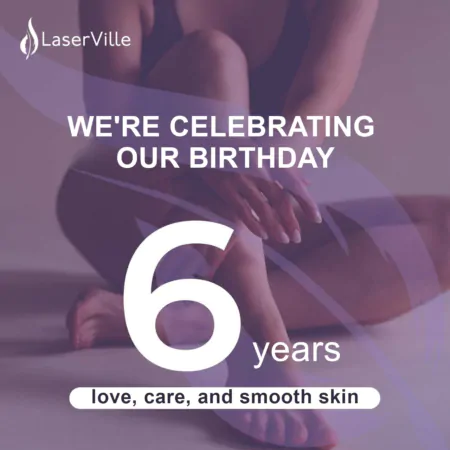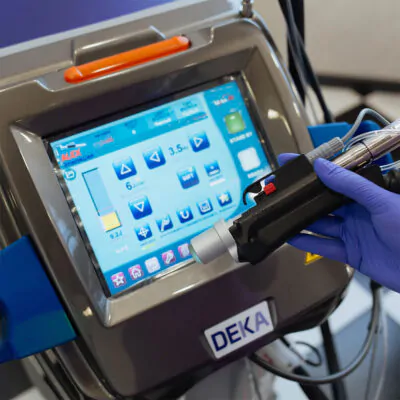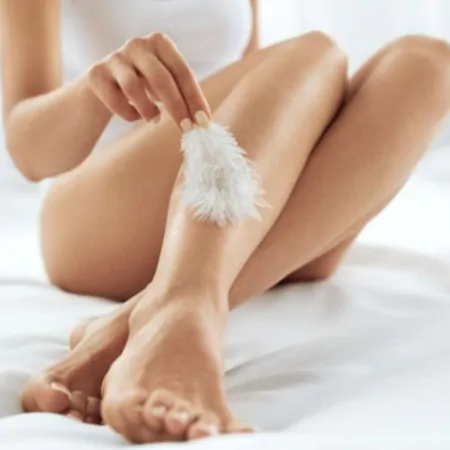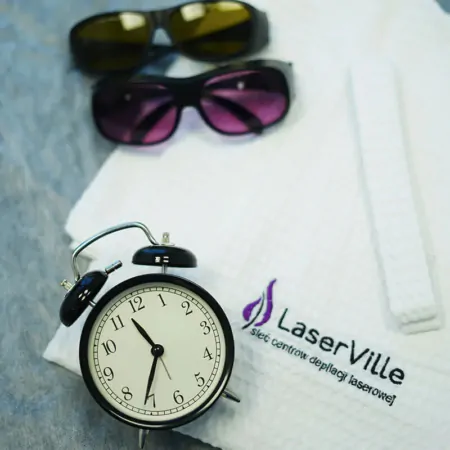Can frequent shaving harm your skin?
Contents
If you have decided to undergo a course of painless laser hair removal at LaserVille, you did so to forget about shaving or using wax strips for a long time. And that’s true. So why do we still find ourselves thinking about shaving?
The fact is, a full course of laser hair removal takes quite a long time. Given the intervals between visits, completing the course can take a whole year or more. That’s why, for some time, shaving will remain a necessary measure for you. Why is this?
Why is the duration of the course so long?
Hair on our body is constantly at different stages of growth, which change in succession. Some hairs are growing (anagen phase) – these are the hairs we see on our skin right now. Other hairs are preparing to “fall out” (catagen phase), and an even larger number of hairs are “sleeping” and will wake up only after a few months. No laser can affect a hair that is still “sleeping” because it does not contain enough melanin to be targeted by the laser.
That’s why the interval between treatments is extended by several weeks to wait for the new dormant hairs to wake up. So, a typical course schedule looks like this:
- First visit
- Second visit – after 1 month
- Third visit – after 1 month + 1 week
- Fourth visit – after 1 month + 2 weeks
- Fifth visit – after 1 month + 3 weeks
- Sixth visit – after 2 months
- Seventh visit (if scheduled) – after 2 months + 1 week
- Eighth visit (if scheduled) – after 2 months + 2 weeks
This is a very superficial “schedule,” as the number of visits is always determined individually by the specialist. But we see that during the long months, as we gradually remove all unwanted hair, we will still need to remove the regrown hair by other methods between visits.
 Why is shaving recommended between laser hair removal sessions?
Why is shaving recommended between laser hair removal sessions?
The issue is not with the razor but with not damaging the hair follicles between sessions. We need to wait for the “dormant hairs” to successfully “wake up” so that we can remove them. As mentioned before, the laser acts on the melanin pigment in the hair follicle. It is melanin that allows the hair to “absorb and accumulate” the laser’s energy, which destroys the hair follicle completely. Therefore, any hair removal methods that involve pulling out the hair do not allow us to achieve our goal. As a result, to achieve quick results and ensure that all laser hair removal procedures are as effective as possible, you must strictly follow this rule – do not pull out hair but use a razor.
How much hair will regrow between laser hair removal sessions?
With each subsequent session, you will experience less hair regrowth. After the initial procedures, hair typically emerges from the skin in “patches.” This process will continue for several weeks, but the results will be visible even after the first procedure. Hair with a high melanin content will absorb the maximum amount of energy and be destroyed immediately. At the same time, very light hairs with low melanin content will also be affected but will not fall out immediately. They will become weaker and “thinner” and will be completely removed during the following sessions. Dormant hairs, however, will remain completely unaffected because they do not contain melanin, which is targeted by the laser. But as you approach the end of the course, you will see fewer and fewer hairs. After completing the entire course, “maintenance” procedures for removing single regrown hairs can be done once a year.
How often should you shave, and can shaving cause harm?
The frequency of shaving largely depends on the area of skin because hair grows at different rates on different parts of the body. It also depends on your individual needs and preferences. There are no medical recommendations on how often you “should” shave – this is an individual question, and each person answers it for themselves.
However, can improper shaving harm you? Absolutely! There are indeed specific recommendations that, if followed, will make your shaving safe and comfortable:
- DELAY shaving if there are mechanical irritations, cuts, or bacterial acne on your skin to avoid further damaging the skin. Wait for complete healing and renewal of the skin.
- DO NOT shave “dry” – always use special creams, foams, or gels! Shaving a dry skin with a razor is very likely to cause irritation and micro-damage to the skin.
- With such shaving, you may need to go over the same area several times, which increases irritation after shaving.
- Avoid pulling the skin and do not press the razor against the skin! Remember to shave in the direction of hair growth.
- It is NOT recommended to shave before visiting a pool or beach. Pool water usually contains many chemical disinfectants. Even if your skin does not appear red after shaving and you think it is safe, there are many micro-damages on your skin that are invisible to the eye. Through these, chemical compounds can penetrate, which are likely to cause inflammation of the hair follicles. This inflammation can be avoided if you postpone your pool visit for at least 1 day. As for open water bodies, you should be cautious not only of chemicals but also of bacteria and pathogens. Therefore, be very careful when making such decisions.
Take proper care of your skin, be attentive to yourself, and your skin will reward you with a healthy appearance and natural beauty. Our specialists at LaserVille are happy to consult you on any questions about the procedure and the specifics of the course.
We look forward to seeing you at LaserVille for painless and effective laser hair removal.



 Why is shaving recommended between laser hair removal sessions?
Why is shaving recommended between laser hair removal sessions?





























No reviews